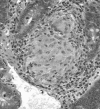Epithelioid granulomas, pattern recognition receptors, and phenotypes of Crohn's disease
- PMID: 15647186
- PMCID: PMC1774832
- DOI: 10.1136/gut.2004.042572
Epithelioid granulomas, pattern recognition receptors, and phenotypes of Crohn's disease
Abstract
Introduction: Crohn's disease is a chronic inflammatory disorder of the gut. It is assumed that a defective interaction between the bacterial flora of the gut and the innate immune system plays a key role in the pathogenesis of the disease. This may lead to specific histological lesions. The epithelioid granuloma is particularly interesting in this regard as it is also observed in several bacterial infections of the gut.
Aims and methods: We hypothesised that genetic or environmental factors with a known influence on inflammation or immunity would lead to an increased prevalence of granulomas. Therefore, surgical specimens from 161 patients were evaluated for the presence of granulomas. Patients were genotyped for the three single nucleotide polymorphisms in caspase recruitment domain 15 (CARD15)/NOD2 associated with CD and for Asp299Gly in Toll-like receptor 4 (TLR4).
Results: The overall prevalence of granulomas was 68.9%. We did not find a significant correlation between granulomas and TLR4 or CARD15 variants. The frequency of granulomas increased with more distal disease (63% small bowel, 72% right colon, 88% left colon, 90% rectum; p=0.01). Granulomas were more frequent in younger patients (odds ratio 0.95 (95% confidence interval 0.92-0.98) p=0.007).
Conclusion: In this study of 161 well documented CD patients, we found no significant association between CARD15 and TLR4 variants and granulomas. This finding seems to refute our initial hypothesis. However, it may be that additional factors are needed for granuloma development. Granulomas may develop only when specific bacterial components are present. Therefore, future research on granuloma pathogenesis should be orientated towards detection and identification of bacterial components in these lesions.
Figures
Comment in
-
Granuloma formation in the different phenotypes of Crohn's disease.Gut. 2005 Feb;54(2):180-1. doi: 10.1136/gut.2004.048082. Gut. 2005. PMID: 15647175 Free PMC article. No abstract available.
References
-
- Forbes A . Clinical presentation and diagnosis of Crohn’s disease. In: Satsangi J, Sutherland LR, eds. Inflammatory bowel disease. Edinburgh: Churchill Livingstone, 2003:183–9.
-
- Shanahan F . Host-flora interactions in inflammatory bowel disease. Inflam Bowel Dis 2004;10:S16–24. - PubMed
-
- Hugot JP, Chamaillard M, Zouali H, et al. Association of NOD2 leucine-rich repeat variants with susceptibility to Crohn’s disease. Nature 2001;411:437–9. - PubMed
-
- Ogura Y , Bonen DK, Inohara N, et al. A frame shift mutation in NOD2 associated with susceptibility to Crohn’s disease. Nature 2001;411:603–6. - PubMed
-
- Lala S , Ogura Y, Osborne C, et al. Crohn’s disease and the NOD2 gene: a role for Paneth cells. Gastroenterology 2003;125:47–57. - PubMed
Publication types
MeSH terms
Substances
LinkOut - more resources
Full Text Sources
Medical



